
- The Contents
- The Making of
- Where Are They Now
- Frequently Asked Questions
- Q & A with Ed Stone

golden record
Where are they now.
- frequently asked questions
- Q&A with Ed Stone
Galleries of Images Voyager Took
The Voyager 1 and 2 spacecraft explored Jupiter, Saturn, Uranus and Neptune before starting their journey toward interstellar space. Here you'll find some of those iconic images, including "The Pale Blue Dot" - famously described by Carl Sagan - and what are still the only up-close images of Uranus and Neptune.
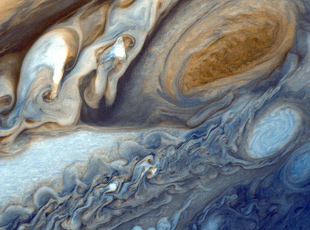
Photography of Jupiter began in January 1979, when images of the brightly banded planet already exceeded the best taken from Earth. Voyager 1 completed its Jupiter encounter in early April, after taking almost 19,000 pictures and many other scientific measurements. Voyager 2 picked up the baton in late April and its encounter continued into August. They took more than 33,000 pictures of Jupiter and its five major satellites.
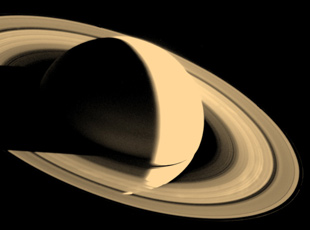
The Voyager 1 and 2 Saturn encounters occurred nine months apart, in November 1980 and August 1981. Voyager 1 is leaving the solar system. Voyager 2 completed its encounter with Uranus in January 1986 and with Neptune in August 1989, and is now also en route out of the solar system.
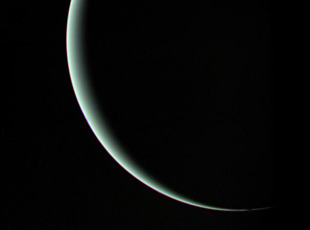
NASA's Voyager 2 spacecraft flew closely past distant Uranus, the seventh planet from the Sun, in January. At its closet, the spacecraft came within 81,800 kilometers (50,600 miles) of Uranus's cloudtops on Jan. 24, 1986. Voyager 2 radioed thousands of images and voluminous amounts of other scientific data on the planet, its moons, rings, atmosphere, interior and the magnetic environment surrounding Uranus.
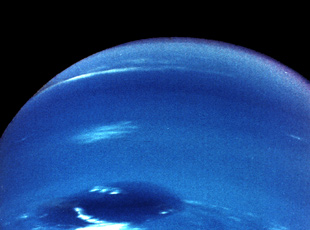
In the summer of 1989, NASA's Voyager 2 became the first spacecraft to observe the planet Neptune, its final planetary target. Passing about 4,950 kilometers (3,000 miles) above Neptune's north pole, Voyager 2 made its closest approach to any planet since leaving Earth 12 years ago. Five hours later, Voyager 2 passed about 40,000 kilometers (25,000 miles) from Neptune's largest moon, Triton, the last solid body the spacecraft will have an opportunity to study.
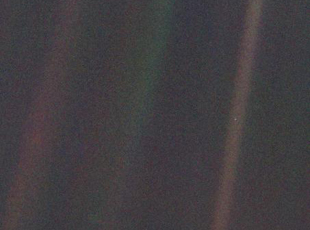
This narrow-angle color image of the Earth, dubbed 'Pale Blue Dot', is a part of the first ever 'portrait' of the solar system taken by Voyager 1. The spacecraft acquired a total of 60 frames for a mosaic of the solar system from a distance of more than 4 billion miles from Earth and about 32 degrees above the ecliptic. From Voyager's great distance Earth is a mere point of light, less than the size of a picture element even in the narrow-angle camera. Earth was a crescent only 0.12 pixel in size. Coincidentally, Earth lies right in the center of one of the scattered light rays resulting from taking the image so close to the sun. This blown-up image of the Earth was taken through three color filters -- violet, blue and green -- and recombined to produce the color image. The background features in the image are artifacts resulting from the magnification.
Voyager Image Gallery
45 years of voyager i and ii.
Launched in 1977, NASA’s twin Voyager spacecraft inspired the world with pioneering visits to Jupiter, Saturn, Uranus, and Neptune. Their journey continues 45 years later as both probes explore interstellar space, the region outside the protective heliosphere created by our Sun. Researchers – some younger than the spacecraft – are now using Voyager data to solve mysteries of our solar system and beyond.

This archival photo shows engineers working on vibration acoustics and pyro shock testing of NASA’s Voyager on Nov. 18, 1976.

NASA’s Voyager 1 acquired this image of a volcanic explosion on Io on March 4, 1979, about 11 hours before the spacecraft’s closest approach to the moon of Jupiter.

This updated version of the iconic "Pale Blue Dot" image taken by the Voyager 1 spacecraft uses modern image-processing software and techniques to revisit the well-known Voyager view while attempting to respect the original data and intent of those who planned the images.

This illustrated graphic was made to mark Voyager 1’s entry into interstellar space in 2012. It puts solar system distances in perspective, with the scale bar in astronomical units and each set distance beyond 1 AU (the average distance between the Sun and Earth) representing 10 times the previous distance.

This graphic highlights some of the Voyager mission’s key accomplishments. Credit: NASA/JPL-Caltech Full image details

This graphic provides some of the mission’s key statistics from 2018, when NASA’s Voyager 2 probe exited the heliosphere. Credit: NASA/JPL-Caltech Full image details
NASA's Voyager probes have been traveling through space for nearly 46 years. Here are 18 groundbreaking photos from their incredible mission.
- Nearly 46 years after their launch, Voyager 1 and 2 will likely soon reach the end of their scientific mission .
- NASA recently lost contact with Voyager 2 after sending it a bad command by mistake.
- Here are 18 pictures the probes took over the course of their forty-plus-year journey.

The Voyager probes are pioneers of science, making it farther into space than any other manufactured object. But now, they face a terminal problem: their power is running out.
The twin probes were originally sent on a four-year mission to tour the solar system, but they exceeded all expectations and are still going nearly 46 years later. That makes them NASA's longest-lived mission.
Scientists are now doing their best to keep the probes going for as long as possible. They recently found a clever hack to extend Voyager 2's life for another three years and plan to do the same with Voyager 1.
But these are old machines and NASA is constantly scrambling to fix mistakes. Last year, Voyager 1 started sending garbled data from the outside of the solar system. NASA ultimately figured out one of its computers had gone dead.
Voyager 2 is now in limbo , as the agency revealed Friday it had lost contact with the probe when someone sent a wrong command. It could be the end of Voyager 2's mission if NASA can't fix the mistake, which the agency probably won't be able to do before October.
As the probes are nearing the end of their scientific mission, here are 18 images from Voyager that changed science.
The Voyager probes were designed to visit Jupiter and Saturn.
The Voyager mission included two probes — Voyager 1 and Voyager 2 — which NASA launched in 1977 within a few months of each other.
NASA took advantage of a rare planet alignment to turbocharge their journeys into space.
NASA originally built the probes to last five years, but they have exceeded that lifespan many times .
As of August 20 and September 5, 2023, Voyager 2 and Voyager 1 will have been traveling for 46 years, respectively.
This is what Voyager 1 saw on its approach to Jupiter.
Voyager 1 and Voyager 2 reached Jupiter in 1979.
As they flew by the planet, they took about 50,000 pictures of Jupiter. These blew away scientists, as the quality of the pictures was much better than those taken from Earth, according to NASA.
These snaps taught scientists important facts about the planet's atmosphere, magnetic forces, and geology that would have been difficult to decipher otherwise.
The probes discovered two new moons orbiting Jupiter: Thebe and Metis.
They also spotted a thin ring around Jupiter.
The probe captured this picture as it was looking back at the planet backlit by the Sun.
Voyager 1 discovered volcanoes at the surface of Io, one of Jupiter's moons.
Next stop: Saturn.
In 1980 and 1981, the probes reached Saturn . The flyby gave scientists unprecedented insight into the planet's ring structure, atmosphere, and moons.
Voyager snapped Saturn's rings in more detail than ever before.
And showed every secret that Enceladus, Saturn's moon, had to offer.
Saturn, snapped as the probe flew away, was shown in a new light.
By 1986, Voyager 2 had made it to Uranus.
By 1986, Voyager 1 has finished its grand tour of the solar system, and few out towards space. But Voyager 2 kept on its exploring our nearest planets, passing 50,600 miles away from Uranus in January 1986.
Voyager 2 discovered two extra rings around Uranus , revealing the planet had at least 11, not 9.
Voyager 2 also spotted 11 previously unseen moons around Uranus.
Here is a picture of Miranda, Uranus's sixth-biggest moon.
Voyager 2 was the first spacecraft to observe Neptune from a close distance.
In 1989, 12 years after its launch, Voyager 2 passed within 3,000 miles of Neptune.
Here's Nepture taken by Voyager 2, in all its blue glory.
Voyager 2 took this unflattering pic of Triton's rough face.
It captured Triton, Neptune's moon in unprecedented detail.
And snapped Triton's southern hemisphere.
As it flew by, Voyager 2 uncovered Neptune's rings.
As its parting gift, Voyager 2 took this beautiful picture of light grazing Neptune's south pole.
This is Voyager 2's last picture. Since it wouldn't come across another planet on its ongoing journey, NASA switched off its cameras after its flyby of Neptune to conserve energy for other instruments.
Voyager 1 had one last trick up its sleeve.
As its last photographic hurrah in 1990, Voyager 1 took 60 images of the solar system from 4 billion miles away.
It gave us the Earth's longest selfie, dubbed the "pale blue dot."
This remains the longest-range selfie: a portrait of the Earth taken by a human-made probe from 4 billion miles away.
After this picture, NASA switched off Voyager 1's cameras to save energy. NASA could switch the probes' cameras back on , but it is not a priority for the mission.
Beyond the solar system
Though the probes are no longer sending pictures, they haven't stopped sending crucial information about space.
In 2012, Voyager 1 became the first human-made instrument to cross into interstellar space by crossing the boundary between our solar system and the rest of the universe, called the heliopause.
Voyager 2 was second, crossing that threshold in 2018 . The probe revealed that there was yet another layer outside of our heliosphere.
The probes keep sending back measurements from interstellar space, like weird hums likely coming from vibrations made by neighboring stars.
Even after their instruments are switched off, the probes' mission continues.
NASA is planning to switch more of the probes' instruments in the hope of extending their life to the 2030s.
But even after all their instruments become quiet, their mission will carry on. As they drift off, they will still be carrying a golden record that carries crucial information about humanity. If intelligent extraterrestrial life exists, they could use that information to reach out to us.
This article was originally published on June 6, 2022, and is being updated with the latest developments about Voyager 1 and 2.
- Main content
- Become A Member
- Gift Membership
- Kids Membership
- Other Ways to Give
- Explore Worlds
- Defend Earth
How We Work
- Education & Public Outreach
- Space Policy & Advocacy
- Science & Technology
- Global Collaboration
Our Results
Learn how our members and community are changing the worlds.
Our citizen-funded spacecraft successfully demonstrated solar sailing for CubeSats.
Space Topics
- Planets & Other Worlds
- Space Missions
- Space Policy
- Planetary Radio
- Space Images
The Planetary Report
The eclipse issue.
Science and splendor under the shadow.
Get Involved
Membership programs for explorers of all ages.
Get updates and weekly tools to learn, share, and advocate for space exploration.
Volunteer as a space advocate.
Support Our Mission
- Renew Membership
- Society Projects
The Planetary Fund
Accelerate progress in our three core enterprises — Explore Worlds, Find Life, and Defend Earth. You can support the entire fund, or designate a core enterprise of your choice.
- Strategic Framework
- News & Press

The Planetary Society
Know the cosmos and our place within it.
Our Mission
Empowering the world's citizens to advance space science and exploration.
- Explore Space
- Take Action
- Member Community
- Account Center
- Eclipse 2024
- “Exploration is in our nature.” - Carl Sagan
Rae Paoletta • Mar 03, 2022
The best space pictures from the Voyager 1 and 2 missions
Launched in 1977, NASA’s Voyager 1 and 2 missions provided an unprecedented glimpse into the outer solar system — a liminal space once left largely to the imagination. The spacecraft provided views of worlds we’d never seen before, and in some cases, haven’t seen much of since.
The Voyager probes were launched about two weeks apart and had different trajectories, like two tour guides at the same museum. Only Voyager 2 visited the ice giants — Uranus and Neptune — for example.
The Voyagers hold a unique position in the pantheon of space history because they’re still making it; even right now, Voyagers 1 and 2 are the only functioning spacecraft in interstellar space. Both hold a Golden Record that contains sights and sounds of Earth in case alien life were to find one of the spacecraft.
As the Voyager missions voyage on, it’s good to look back at how they captured our solar system before leaving it.
This content is hosted by a third party (youtube.com), which uses marketing cookies. Please accept marketing cookies to watch this video.
Let’s Go Beyond The Horizon
Every success in space exploration is the result of the community of space enthusiasts, like you, who believe it is important. You can help usher in the next great era of space exploration with your gift today.
For full functionality of this site it is necessary to enable JavaScript. Here are instructions on how to enable JavaScript in your web browser .
- The Inventory
Support Quartz
Fund next-gen business journalism with $10 a month
Free Newsletters
Let’s take a moment to look at the mesmerizing images from Voyager 1
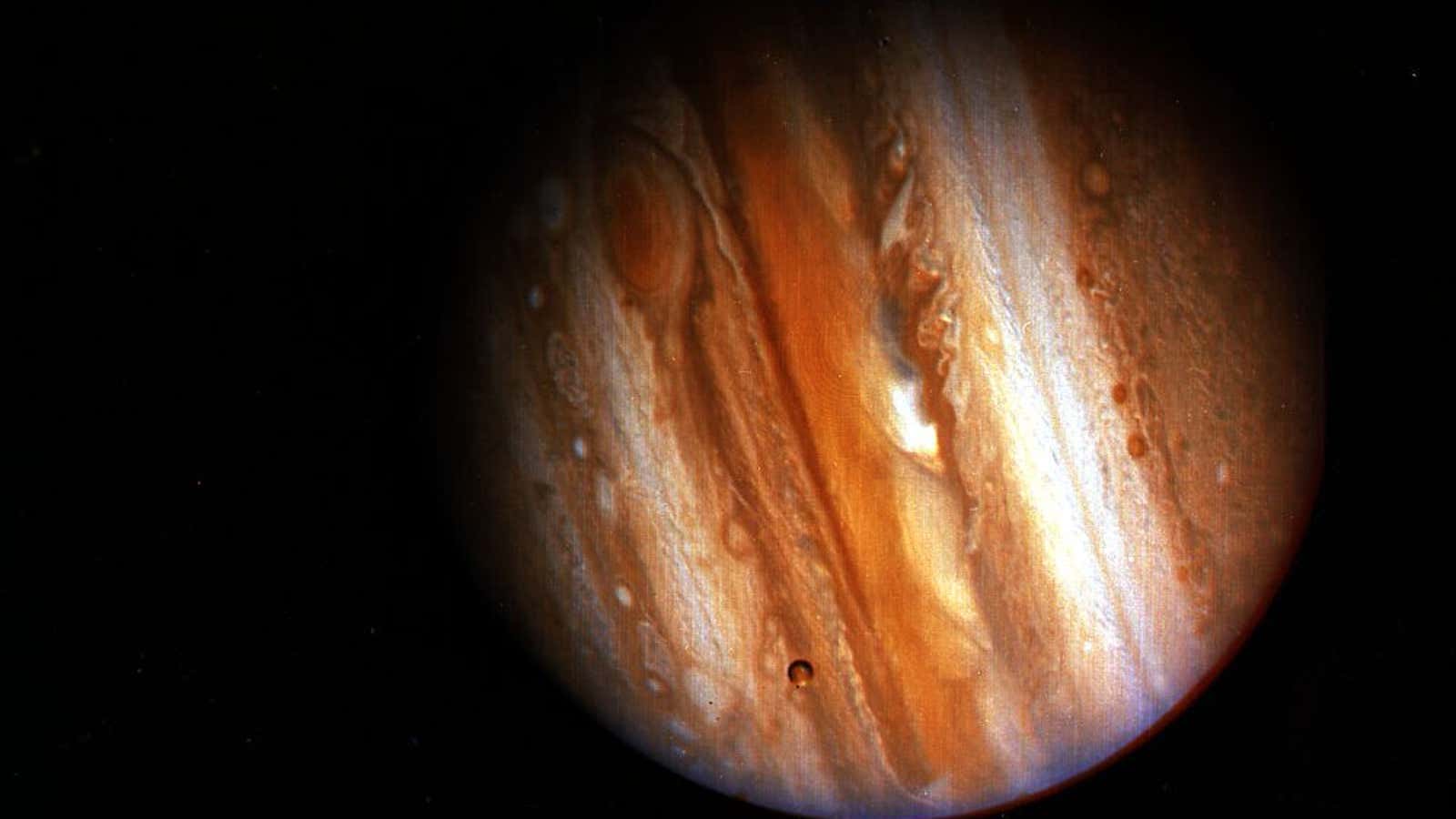
In 1977, NASA launched two Voyager probes, equipped with golden records describing human accomplishment, on a mission to explore the farthest reaches of the solar system. Each record catalogued our music, our greetings, our art and photography.
Forty years later, both spacecrafts are still hurtling through space , exploring parts of the universe where nothing from Earth has visited before. Voyager 1 is now in interstellar space, 13 billion miles away from Earth. Voyager 2 is passing through the heliosheath, the outermost layer of the heliosphere, before it, too, reaches interstellar space.
Last week, in an amazing feat of engineering, NASA engineers turned on Voyager 1’s backup thrusters after they’d been dormant for 37 years. The thrusters will help reorient the spacecraft’s antenna back to Earth, so we can receive its signal for just a little longer.
It’s a fine moment to reflect on the incredible images Voyager 1 has sent back over its lifetime. The probe gave us the first “ portrait ” of our solar system, and memorably mesmerizing shots of Saturn and Jupiter.
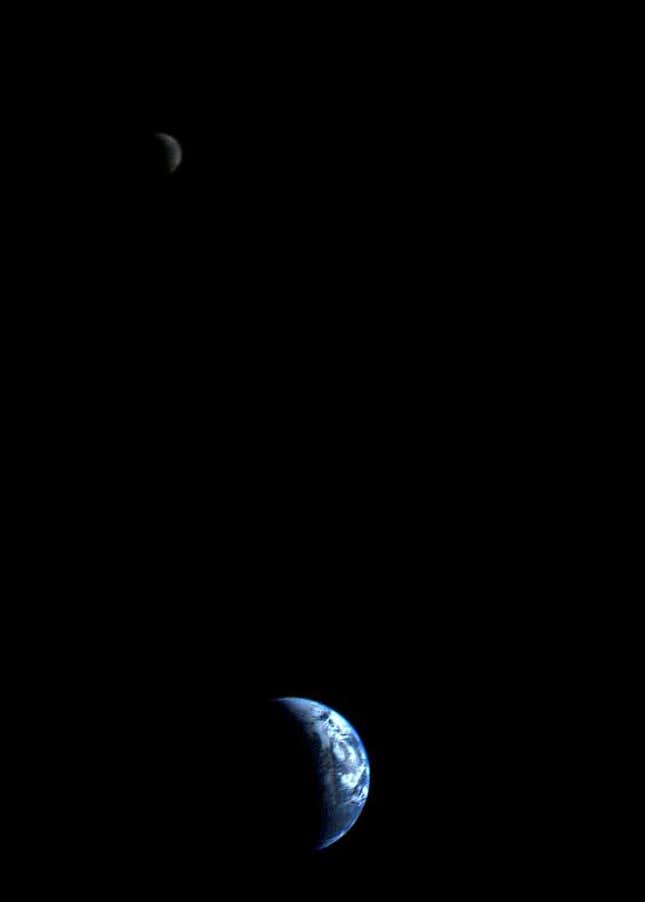
Watch NASA’s moving compilation of images from both Voyagers below:
📬 Sign up for the Daily Brief
Our free, fast, and fun briefing on the global economy, delivered every weekday morning.
Voyager 1's Historic Flyby of Jupiter in Photos
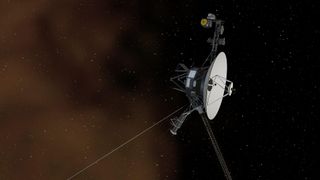
On March 5, 1979, NASA's Voyager 1 flew by Jupiter , the largest planet in the solar system, in a historic encounter with the largest planet in our solar system. The photos of Jupiter beamed back by Voyager 1 were amazing, as was the science they returned. See Voyager 1's most amazing photos of Jupiter and its moons in our gallery here.

Parts of a Whole
Voyager 1 and 2 launched in 1977 to explore the cosmos. Voyager 1 took a series of images of Jupiter, which were compiled to create this mosaic of one entire hemisphere of the planet.
While the two spacecraft were originally designed for a five-year mission to explore Jupiter and Saturn, their successes and reliability allowed for additional exploration of Uranus, Neptune and more.
Credit: JPL
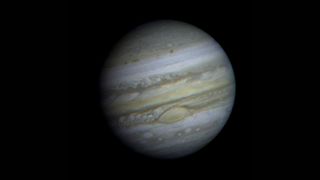
Standing Out in the Cosmos
Voyager 1 took three separate photos, using three different color filters, of Jupiter this day in 1979. Back on Earth in the Image Processing Lab at Jet Propulsion Laboratory, the images were combined, creating this colorful and breathtaking view of the Jovian planet.
Credit: JPL/NASA
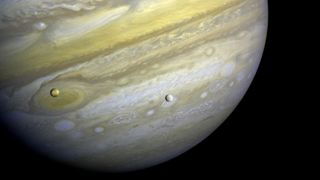
A Planet and Two Moons
Io, Europa and Jupiter pose for a family photo. Io seems almost caught in Jupiter's Great Red Spot and glows with a very different color from Europa. Europa, on the other hand gives away very little detail about its composition with a glance from such a distance.
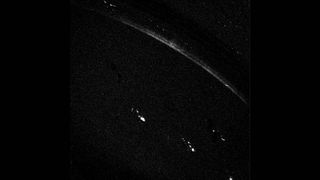
Jupiter's Night Light(s)
From within Jupiter's shadow Voyager 1 sent home this image detailing the planet's north pole, an aurora in action and possibly even some lightning. The image itself was taken over a long exposure of 3 minutes, 12 seconds with a wide angle camera.

A Window Inside?
Researchers believe this large brown oval, which was imaged Mar. 2, 1979, could allow a view into lower cloud levels of Jupiter if studied more closely.
Just above the brown spot lies the pale orange North Temperate Belt bordered to the south by the high speed North Temperate Current which moves with wind speeds up to 260 mi/hr (120 meters/sec).

A Big Ol' Spot
In early March 1979, Voyager 1 collected this image of the Great Red Spot and some other surrounding atmospheric activity. The smallest white ovals featured are 20 miles (30 km) across, some of which were observed four decades ago, at formation. The different disturbances in Jupiter's atmosphere move around the planet at different speeds.
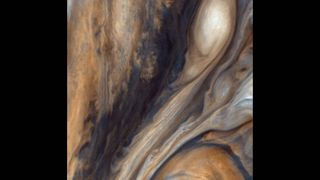
Such Beautiful Contrast
Just below Jupiter's Great Red Spot, the planet's atmosphere has a great variation of textures and patterns. Using special computer processing, these details are enhanced to enable study in hopes of deepening understanding of the Jovian atmosphere.

Ring Around the Jupiter
On Mar. 4, 1979, this multiple exposure image provided the first evidence of a ring around the Jovian planet. Stars in the image appear as broken hairpins resulting from Voyager 1's motion during the more than 11 minute exposure. The image successfully completed it mission of searching for such rings at Jupiter.
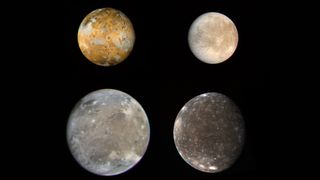
The Galilean Moons of Jupiter
In 1610, Galileo Galilei observed these four moons orbiting Jupiter. As a result, the group is referred to as the Galilean satellites of Jupiter. Shown here the relative sizes are compared — Io, on the top left; Europa, on the top right; Ganymede, on the bottom left; and Callisto, on the bottom right.
Ganymede and Callisto are larger than planet Mercury while Io and Europa are similar in size to Earth's moon. Io consists of active volcanoes and likely has a sulfurous composition. Ganymede and Callisto appear to consist mainly of water and water ice. Europa's make up is still largely a mystery waiting to be solved.
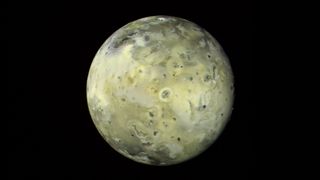
Active Volcanoes
To create this image of Jupiter's Io, several photos of the moon were snapped by Voyager 1 on Mar. 4, 1979. Centered on the moon a circular element has been connected to an known erupting volcano while across the image similar features can be identified. Io is the first-known body, other than Earth, where active volcanism has been seen.
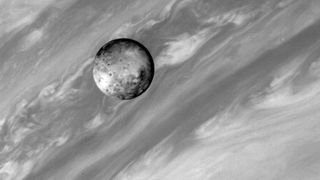
Photobomber
While mapping Jupiter, Io snuck into the frame. Voyager 1 captured the side of the moon Jupiter never sees, revealing never-before-seen details of the Jovian satellite: several circles with dark centers and bright rims may be craters unknown on the moon until now. Without further study, researchers won't know if they are impact of volcanic craters.

Surprising Natural Colors
A color image of Jupiter's closest Galilean moon, Io, stuns viewers with its rich colors. Scientists believe the orange and red hues arise from sulfur compounds, salts and other volcanic sublimates. While volcanic craters and lava flows may explain the dark spots across the image.
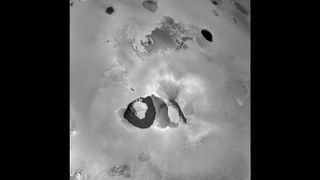
Loki, In Detail
The detailed structure of Loki, a volcano on Jupiter's Io, visualized clearly here in a Voyager 1 image. In this photo, the majority of the eruptive activity emanated from the possible rift in the dark linear feature. Also, a u-shaped "lava-lake" component reveals strange details, possibly solid sulfur "icebergs" in a liquid sulfur lake. This region claimed the hottest area on this moon at about 150 degrees Celsius.

Activity Afar
An active plume near the Loki volcano shines off the horizon of Io. The mosaic also presents views of fallout deposits from the active plume Pele at the heart-shaped feature to the southeast of Loki.
Credit: JPL/USGS/NASA
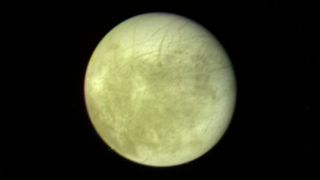
Small but Not Insignificant
The smallest of the Galilean moons, Europa displays bright areas, surmised to be ice deposits, and darker spots expected to be rocky surfaces. Long linear structures across the northern hemisphere are features unique on the satellite. One theory suggests these lines could be fractures or faults in the moon's surface.
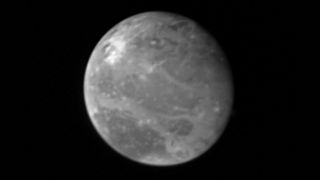
Similar but Not the Same
From about 2.6 million miles (4.2 million km) away, Voyager 1 snapped this image of Ganymede. Though larger than planet Mercury, the moon is much less dense. Ganymede, while reminiscent of Earth's moon, is four times as bright. Scientists speculate the Jovian moon could have areas, such as the north polar region, covered in water frost creating the brightness seen here.
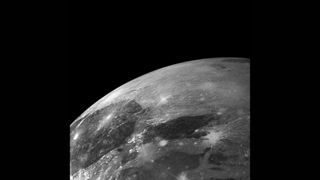
Explaining the Sights
Several bright impact craters glow brightly in Voyager 1's image of Ganymede from Mar. 5, 1979. Many older impact craters, missing their rays, are visible as well. Some of the erosion may be caused by faulting of the surface materials.
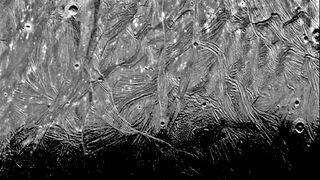
Strange Patterns
Jupiter's largest moon, Ganymede was imaged by Voyager 1 on Mar. 5, 1979. The image reveals intricate patterns of ridges and grooves. Scientists believe these features to be deformations in the satellite's thick icy crust.
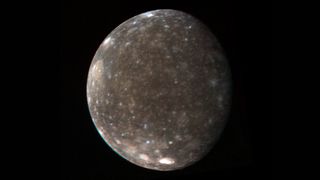
A Trio of Info
Three images of Jupiter's Callisto combine to create this high resolution photo of the satellite. A large basin-like feature, discovered by Voyager 1, appears clearly on the upper left area of the moon. Across the center of this basin a brighter contrast is seen. Researchers believe these shining areas contain more clean ice as compared to the majority of Callisto's "dirty-ice" surface.
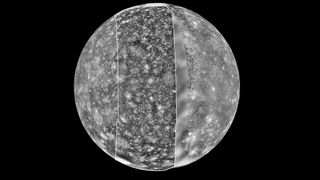
A Triad of Data
A mosaic of Callisto came from three different spacecraft. Voyager 1 contributed the left-side image and Voyager 2 provided the right-side image, both collected in 1979. The third, central portion originated from Galileo in September of 1996.
Credit: JPL/DLR/NASA
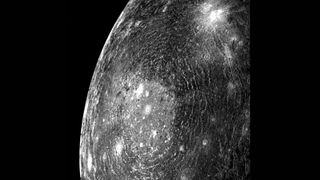
A Peak at What's Inside
March 6, 1979, Voyager 1 snapped this image of Callisto, one of Jupiter's largest moons, from almost 200,000 km away. The central focus of the image shows the complex circular structure that mirrors impact basins seen on Earth's moon and planet Mercury. Experts believe the patterns on Callisto demonstrate the planet's low density and lack of internal strength.

Christine Lunsford joined the Space.com team in 2010 as a freelance producer and later became a contributing writer, covering astrophotography images, astronomy photos and amazing space galleries and more. During her more than 10 years with Space.com, oversaw the site's monthly skywatching updates and produced overnight features and stories on the latest space discoveries. She enjoys learning about subjects of all kinds.
NASA gets $25.4 billion in White House's 2025 budget request
'Interstellar meteor' vibrations actually caused by a truck, study suggests
Satellite views of solar eclipse 2024: See the moon's shadow race across North America (video, photos)
Most Popular
By All About Space magazine May 28, 2023
By Fran Ruiz May 06, 2023
- 2 Total solar eclipse 2024: Live updates
- 3 These solar eclipse 2024 photos from our readers are absolutely amazing (images, video)
- 4 I proposed to my fiancée under the diamond ring of the 2024 total solar eclipse. (She said 'Yes!')
- 5 'Heavy' history: ULA launches final Delta rocket after 64 years (video, photos)

More From Forbes
Nasa discovers source of voyager 1 glitch in interstellar space.
- Share to Facebook
- Share to Twitter
- Share to Linkedin
A NASA image of one of the Voyager space probes. Voyager 1 and its identical sister craft Voyager 2 ... [+] were launched in 1977 to study the outer Solar System and eventually interstellar space. (Photo by NASA/Hulton Archive/Getty Images)
NASA’s pioneering Voyager 1 spacecraft has a memory problem. The space agency has been troubleshooting the elderly machine since it began sending back gibberish communications in November. NASA hasn’t fixed Voyager 1 yet, but engineers now know what’s vexing the spacecraft.
The glitch paused Voyager 1’s science work and kicked off a long-distance diagnosis process. The team traced the issue to the flight data subsystem, a computer that talks to the spacecraft’s telemetry modulation unit to send science and engineering data to Earth. The data came back unintelligible. The culprit appears to be a single chip that’s part of the FDS.
The breakthrough came thanks to a “poke” NASA sent in March that prompted Voyager 1 to send back a readout of its FDS memory. “Using the readout, the team has confirmed that about 3% of the FDS memory has been corrupted, preventing the computer from carrying out normal operations,” NASA said in a statement on April 4.
Voyager 1’s position so far away from home creates a lot of challenges when it comes to fixing problems. NASA talks to the spacecraft over a distance of over 15 billion miles. It takes 22.5 hours for a radio signal to reach Voyager 1 and it takes an equally long time to receive a response. It’s troubleshooting in slow motion. It also means figuring out the exact cause of the glitch is mostly educated guesswork. It could be damage or it could be a matter of age. “Engineers can’t determine with certainty what caused the issue,” said NASA. “Two possibilities are that the chip could have been hit by an energetic particle from space or that it simply may have worn out after 46 years.”
There’s reason for optimism, though Voyager 1 won’t make a quick recovery. “Although it may take weeks or months, engineers are optimistic they can find a way for the FDS to operate normally without the unusable memory hardware, which would enable Voyager 1 to begin returning science and engineering data again,” NASA said.
Best High-Yield Savings Accounts Of 2024
Best 5% interest savings accounts of 2024.
Voyager 1 has made an unprecedented journey across space. It launched in 1977 on an initial mission to study our solar system and visit Jupiter and Saturn. That was just the beginning. The resilient spacecraft kept on going and eventually entered interstellar space in 2012. It was the first human-made object to venture into the unexplored territory outside our solar system. Voyager 1’s twin Voyager 2 crossed over into interstellar space in 2018.
NASA turned off some of Voyager 1’s science instruments as the spacecraft aged, but the probe has still been returning valuable data on interstellar space. If a fix works, Voyager 1 will get back into the swing of science and write yet another chapter in an epic story of exploration.

- Editorial Standards
- Reprints & Permissions

IMAGES
VIDEO
COMMENTS
Voyager 1 completed its Jupiter encounter in early April, after taking almost 19,000 pictures and many other scientific measurements. Voyager 2 picked up the baton in late April and its encounter continued into August. They took more than 33,000 pictures of Jupiter and its five major satellites.
Voyager 1 took photos of Jupiter and two of its satellites (Io, left, and Europa). Prev Page 11 of 15 Next Prev Page 11 of 15 Next . Enhanced color view of Saturn's ring system captured by Voyager ...
This is an image of the planet Uranus taken by the spacecraft Voyager 2 in 1986. Credit: NASA/JPL-Caltech. Full Image Details. This image, taken by NASA's Voyager 2 early in the morning of Aug. 23, 1989, is a false color image of Triton, Neptune's largest satellite; mottling in the bright southern hemisphere is present.
Early Voyager 1 Images of Jupiter Full Resolution: TIFF (491.5 kB) JPEG (21.78 kB) 1996-09-26: Jupiter: Voyager: Imaging Science Subsystem: 400x400x3: PIA00029: First Close-up Image of Jupiter from Voyager ...
Here are 18 groundbreaking photos from their incredible mission. This montage shows examples of striking images of the solar system Voyager 1 and 2 took on their missions. NASA/JPL/Insider. Nearly ...
Image: NASA / JPL / Ted Stryk. Saturn as seen by Voyager 1 The last picture from Voyager 1's approach to Saturn in which the entire planet and ring system can be seen in a single frame. Image: NASA/JPL/Björn Jónsson. Voyager 2's best view of Enceladus This was the Voyager mission's best view of Enceladus, captured by Voyager 2 on August 26 ...
Voyager 1 Perspective for Family Portrait Full Resolution: TIFF (2.496 MB) JPEG (336.9 kB) 2021-05-11: Voyager: 1241x427x3: PIA24572: Weak and Strong Plasma Oscillation Signals Full Resolution: TIFF (960.8 kB) JPEG (80.75 kB) 2021-11-30: Europa: Galileo Voyager: 1100x600x3: PIA24895: Three Views of Europa Full Resolution: ...
On Feb. 14, 1990, NASA's Voyager 1 probe snapped a photo of Earth from 3.7 billion miles (6 billion kilometers) away. The image shows our home planet as it truly is — a tiny, lonely outpost of ...
Our crescent Earth and moon in the first picture of its kind ever captured by a spacecraft. Taken on Sept. 18, 1977, 7 million miles (12 million km) away from Earth. Voyager 1's closest approach ...
If Voyager 1 failed when taking pictures of Jupiter and Saturn, NASA was prepared to alter Voyager 2's path to follow Voyager 1's trajectory. It would cut off the Uranus and Neptune option, but ...
PIA23645. Language. english. The Pale Blue Dot is a photograph of Earth taken Feb. 14, 1990, by NASA's Voyager 1 at a distance of 3.7 billion miles (6 billion kilometers) from the Sun. The image inspired the title of scientist Carl Sagan's book, "Pale Blue Dot: A Vision of the Human Future in Space," in which he wrote: "Look again at that dot.
Color Voyager 2 Image Showing Crescent Uranus Full Resolution: TIFF (231.9 kB) JPEG (17.76 kB) 1998-06-04: Enceladus: Voyager: VG ISS - Narrow Angle: 1004x1004x3: PIA00347: Voyager 2 Color Image of Enceladus, Almost ...
Voiced by Robert Picardo (Star Trek: Voyager)Explore for yourself:https://www.planetary.org/articles/best-space-pictures-nasa-voyager-missionsNASA's Voyager ...
The New Horizons photo of Voyager 1 (yellow circle), set against a backdrop of stars and galaxies. NASA/Johns Hopkins APL/Southwest Research Institute. In this photo, the two spacecraft are ...
On March 5, 1979, NASA's Voyager 1 flew by Jupiter, the largest planet in the solar system, in a historic encounter with the largest planet in our solar system. See the amazing photos here.
Launched in 1977, NASA's Voyager 1 became the first spacecraft to travel beyond our solar system into interstellar space in 2012.
NASA hasn't fixed Voyager 1 yet, but engineers now know what's vexing the spacecraft. The glitch paused Voyager 1's science work and kicked off a long-distance diagnosis process. The team ...